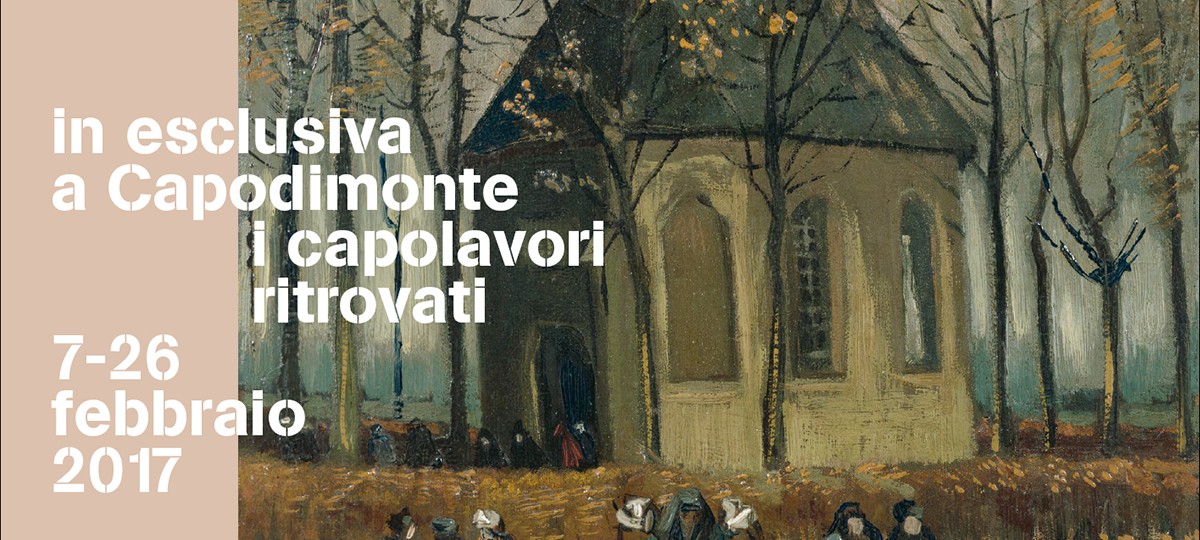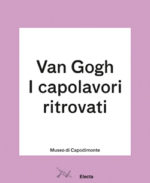“Van Gogh’s painting destroys its own structure as it is constructed, but in the moment when the art burns itself, its full aesthetic value radiates a blinding light”, Giulio Carlo Argan.
From 7th to 26th of February 2017 the two Van Gogh paintings that were stolen 14 years ago from the Van Gogh Museum in Amsterdam by organised crime and found in Italy in a Camorra hideout in September 2016, thanks to the efforts of the Italian Guardia di Finanza and the Prosecutors’ Office in Naples, will be on display to the public at the Museo e Real Bosco di Capodimonte in Naples.
Congregation leaving the Reformed Church in Nuenen (1884-1885) and Seascape at Scheveningen before a Storm (1882), both fundamental to an understanding of the artist’s early work, will be displayed on the second floor of the museum next to the Caravaggio room until 26th February 2017 before returning to Holland.
The exhibition is promoted by the Italian Ministry for Cultural Heritage and Tourism and the Museo e Real Bosco di Capodimonte and financed by the region of Campania. The project is run by Scabec Spa. The catalogue and organisation are courtesy of Electa.
From Amsterdam to Naples, the mysterious journey of the two Van Goghs
7th December 2002 was a black day in the world of art. Two men broke into the Van Gogh Museum through a window and stole two of Vincent Van Gogh’s paintings: Seascape at Scheveningen before the Storm (1882) and Congregation Leaving the Reformed Church in Nuenen (1884-85). The thieves made good their escape through the same window by climbing down a rope, but were arrested shortly after. Sentenced to prison and to refund the damage, the two denied the accusations and refused to collaborate to help find the two paintings, which they had disposed of in the meantime. The paintings disappeared without trace for 14 years until September 2015, when they were found by the Guardia di Finanza during a drug bust involving an international drug ring.
The paintings had ended up in the hands of the criminal organisation the Camorra, hidden under a cloth near the kitchen of the home in Castellamare di Stabia owned by a Camorra boss in hiding. Thanks to the confessions of criminals who had decided to collaborate, the Guardia di Finanza identified the ring’s assets. Coordinated by Giovanni Salerno, they found the paintings during an operation to seize assets to the value of tens of millions of euros, accomplishing an “extraordinary operation reiterating the commitment of the Italian system in the fight against the illicit traffic of artwork”, declared Minister Dario Franceschini.
The two paintings were unexpectedly recovered in good condition, albeit without their frames and with slight damage on the edge of the Nuenen, causing the loss of a fragment of the view and revealing the underlying canvas. Restoration work will be undertaken once the paintings reach Holland.
The Works
The two canvases are essential in understanding Van Gogh’s early work and his Dutch years (1880-1885), during which he was influenced by 17th century northern landscapes and his frustrated vocation to be a preacher is expressed in his dark, realistic paintings, reaching a peak in the Potato Eaters.
Seascape at Scheveningen before the Storm is the only painting in the Van Gogh Museum realised while he was living in The Hague (1881-1883), one of his first paintings after two years dedicated exclusively to drawing, and one of only two seascapes painted by the artist at the time.
Congregation Leaving the Reformed Church in Nuenen, the only painting in the Dutch museum still in its original frame, is an intimate and melancholic masterpiece inspired by memories and family affection. Painted for his mother at the start of 1884, the scene depicts the church of the village of Nuenen where Van Gogh’s father was a pastor. In 1885, after his father’s death, he substituted the isolated farmer in the foreground with a group of churchgoers, and gave the trees darker leaves to convey the autumn weather.
Start date
Tuesday 07 february 2017
End date
Sunday 26 february 2017
Museo e Real Bosco di Capodimonte
Via Miano 2
Napoli
go to site
Promoted by
Italian Ministry for Cultural Heritage and Tourism and the Museo e Real Bosco di Capodimonte

